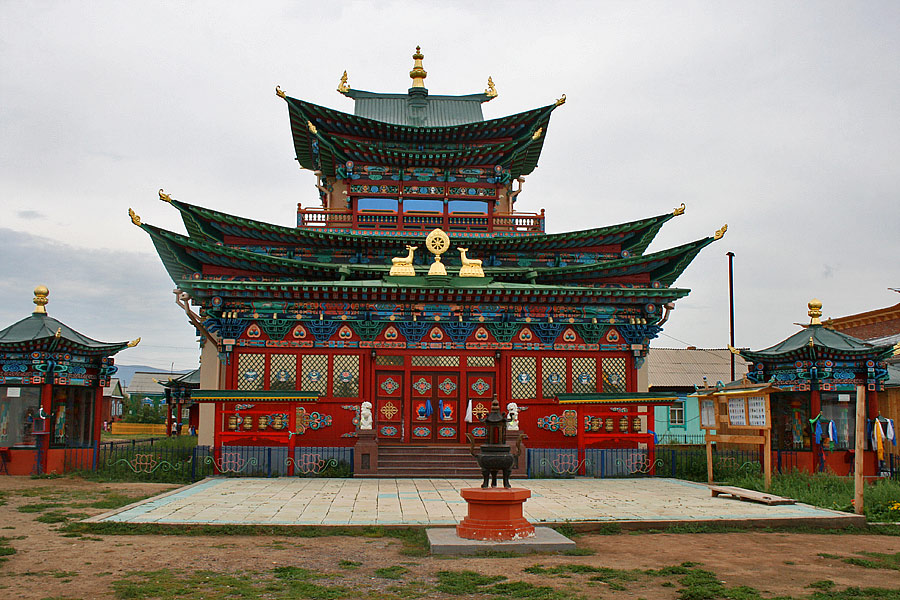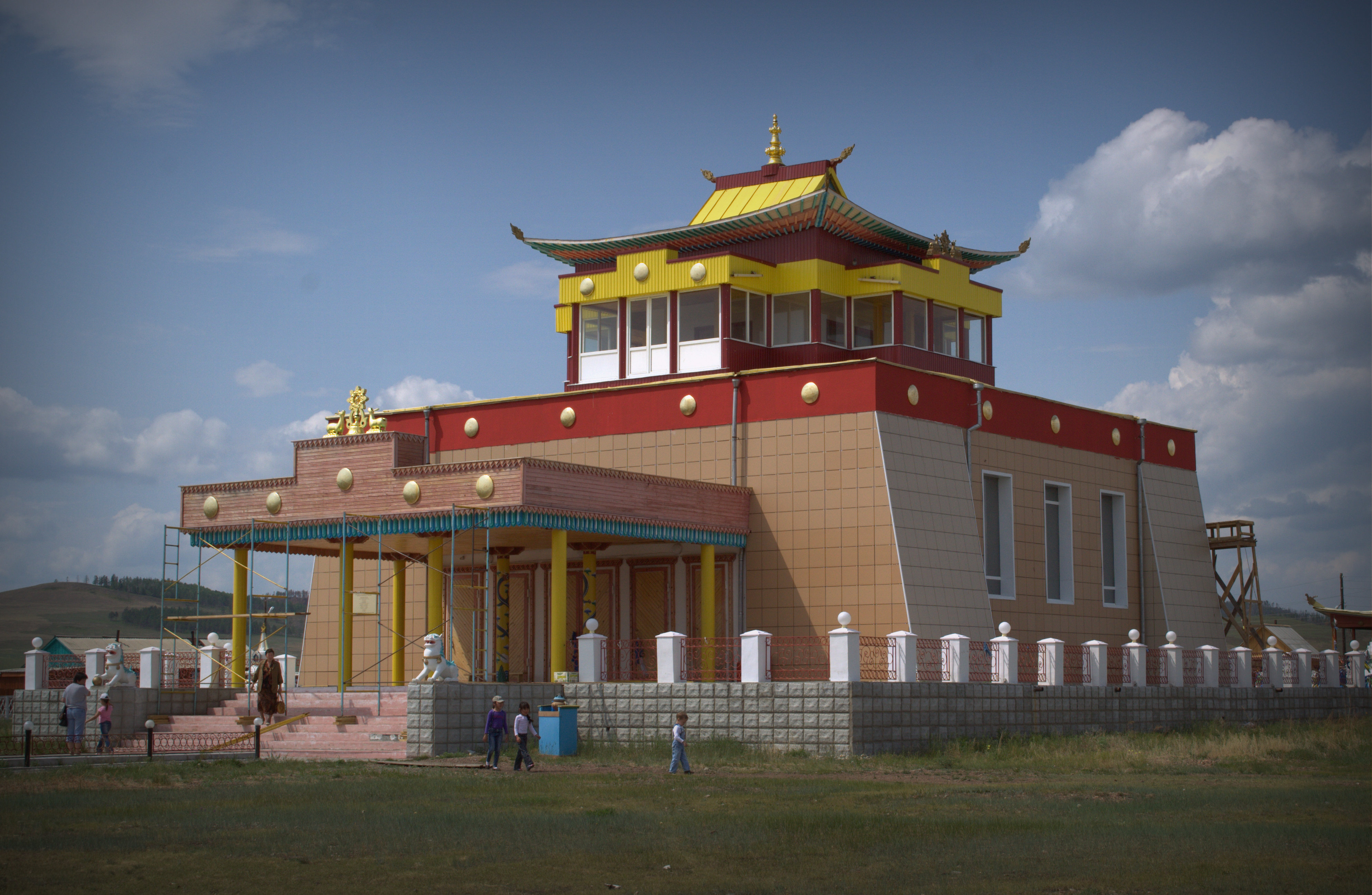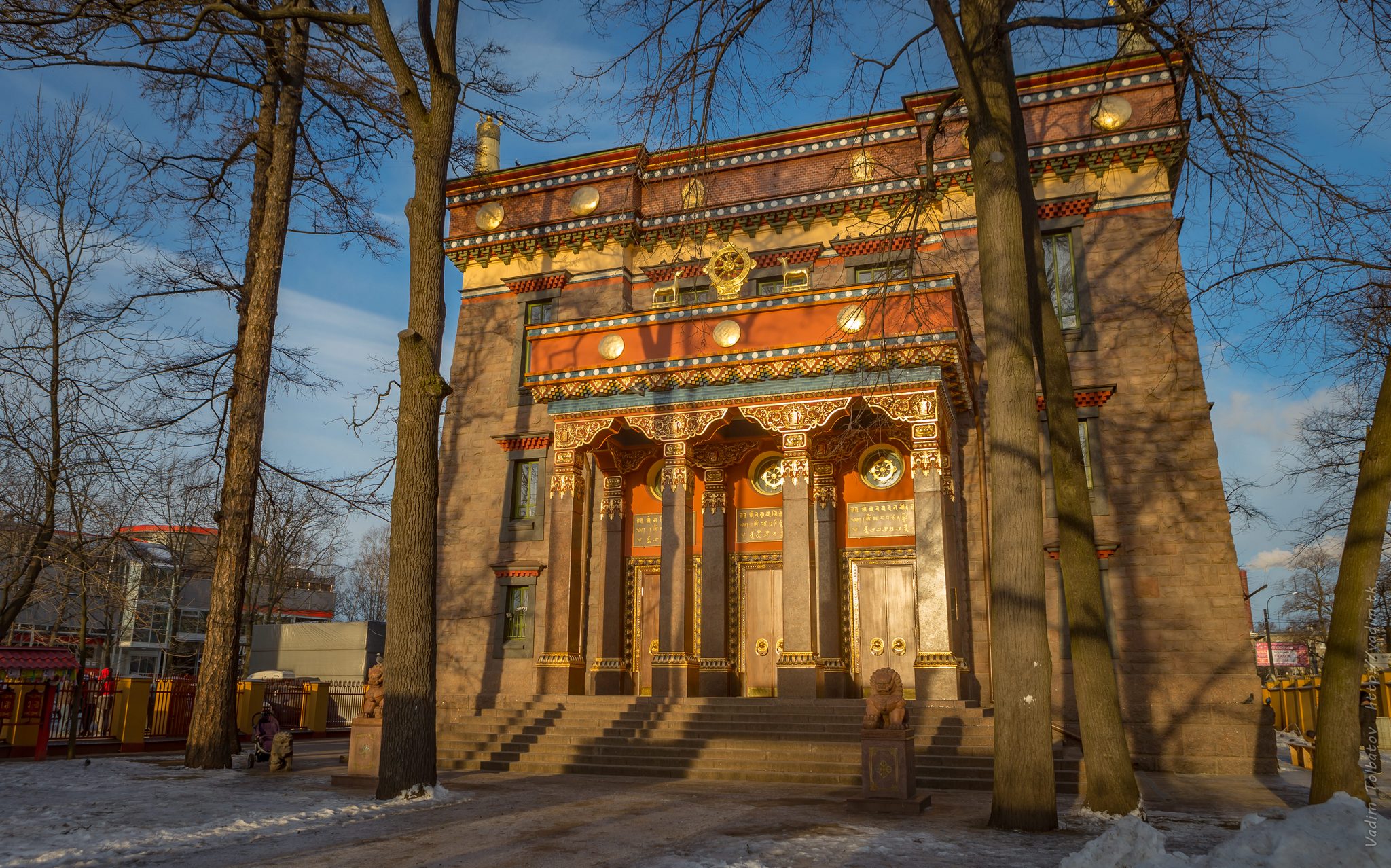|
Datsan
Datsan ( mn, Дацан, russian: Дацан) is the term used for Buddhist university monasteries in the Tibetan tradition of Gelukpa located throughout Mongolia, Tibet and Siberia. As a rule, in a datsan there are two departments—philosophical and medical. Sometimes to them is added the department of the tantric practices where the monks study only after finishing education in the philosophical department. In pre-revolutionary Russia, datsans traditionally existed only in the Buryat territories, most of those now included in Buryatia and Transbaikalia (a number of datsans there has been reconstructed or started since the early 1990s). There was a difference with Tibetan administrative idea: in Tibet, several datsans were education-centered parts of larger organizations, as Drepung, Ganden, and Sera Monastery in Gelugpa tradition. In Russia, datsans were not parts of a larger entity, but rather independent educational and religious centers. In Buryat Buddhism, terms "Budd ... [...More Info...] [...Related Items...] OR: [Wikipedia] [Google] [Baidu] |
Ivolga Monastery
Ivolginsky datsan (russian: Иволгинский Дацан) is the Center of the Buddhist Traditional Sangha of Russia, Buddhist Temple located in Buryatia, Russia, 23 km from Ulan Ude, near Verkhnyaya Ivolga village. History The datsan was opened in 1945 as the only Buddhist spiritual centre of the USSR. In the course of time the little "Khambin's sume" changed into the Monastic centre with a residence of Pandido Khambo lama, the leader of all Russian Lamas. It was the residence of the Central Spiritual Board of Buddhists of the USSR and later of the Buddhist Traditional Sangha of Russia, as well as that of Pandido Khambo lama, the head of the Russian Buddhists. The spiritual activity of the datsan is manifested in temple rites, medical practice, and a traditional system of Buddhist education. The Buddhist university «Dashi Choinkhorling» was opened in 1991 attached to the datsan. Treasures of culture Although built in the late 1940s with light-colored brick ... [...More Info...] [...Related Items...] OR: [Wikipedia] [Google] [Baidu] |
Ivolginsky Datsan
Ivolginsky datsan (russian: Иволгинский Дацан) is the Center of the Buddhist Traditional Sangha of Russia, Buddhist Temple located in Buryatia, Russia, 23 km from Ulan Ude, near Verkhnyaya Ivolga village. History The datsan was opened in 1945 as the only Buddhist spiritual centre of the USSR. In the course of time the little "Khambin's sume" changed into the Monastic centre with a residence of Pandido Khambo lama, the leader of all Russian Lamas. It was the residence of the Central Spiritual Board of Buddhists of the USSR and later of the Buddhist Traditional Sangha of Russia, as well as that of Pandido Khambo lama, the head of the Russian Buddhists. The spiritual activity of the datsan is manifested in temple rites, medical practice, and a traditional system of Buddhist education. The Buddhist university «Dashi Choinkhorling» was opened in 1991 attached to the datsan. Treasures of culture Although built in the late 1940s with light-colored brick ... [...More Info...] [...Related Items...] OR: [Wikipedia] [Google] [Baidu] |
Egituysky Datsan
Egituysky datsan is a Buddhist temple in Buryatia, Russia located in Yeravninsky District. The datsan is kept sacred world of Buddhism – Buddha Sandalwood (Zandan Zhuu) – which is by tradition the only lifetime statue of Buddha is kept Shakyamuni. V datsan world Buddhist shrine – Sandalwood Buddha (Zandan Zhuu) – which is by tradition the only lifetime sculpture of Buddha Shakyamuni Siddhartha Gautama, most commonly referred to as the Buddha, was a wandering ascetic and religious teacher who lived in South Asia during the 6th or 5th century BCE and founded Buddhism. According to Buddhist tradition, he was born in Lu .... History The monastery was founded in 1820. The architecture of Egituysky datsan was one of the most beautiful. Three Dugan – medical, philosophical and astrological – surrounded by the main temple. When datsan operated printing press. In 1937 Egituysky datsan was closed and destroyed. Datsan revived after 1991. Sources Эги ... [...More Info...] [...Related Items...] OR: [Wikipedia] [Google] [Baidu] |
Buryats
The Buryats ( bua, Буряад, Buryaad; mn, Буриад, Buriad) are a Mongolic ethnic group native to southeastern Siberia who speak the Buryat language. They are one of the two largest indigenous groups in Siberia, the other being the Yakuts. The majority of the Buryats today live in their titular homeland, the Republic of Buryatia, a federal subject of Russia which sprawls along the southern coast and partially straddles the Lake Baikal. Smaller groups of Buryats also inhabit Ust-Orda Buryat Okrug (Irkutsk Oblast) and the Agin-Buryat Okrug (Zabaykalsky Krai) which are to the west and east of Buryatia respectively as well as northeastern Mongolia and Inner Mongolia, China. They traditionally formed the major northern subgroup of the Mongols. Buryats share many customs with other Mongols, including nomadic herding, and erecting gers for shelter. Today the majority of Buryats live in and around Ulan-Ude, the capital of the Buryat Republic, although many still follow ... [...More Info...] [...Related Items...] OR: [Wikipedia] [Google] [Baidu] |
Datsan Gunzechoinei
The Datsan Gunzechoinei is a large Buddhist temple in Saint Petersburg, Russia. It is the northernmost Buddhist temple in Russia. History In 1909, Agvan Dorzhiev got permission from the Tsar to build a large and substantial Buddhist ''datsan'' or temple in Saint Petersburg which he hoped would become the residence of the first Buddhist ruler of Russia. However, the Russian Orthodox Church campaigned strongly against construction of this "pagan" temple across the country, which considerably delayed its construction. However, the first service was held on 21 February 1913, and construction was completed by 1915, when Tsar Nicholas II confirmed the arrival of a staff of nine lamas: three from Transbaikalia, four from Astrakhan Province, and two from Stavropol Province. The stained glass windows were commissioned from Nicholas Roerich. A second large service was held on 9 June 1914 to consecrate a large gilded copper statue of the sitting Buddha Shakyamuni, which was a gift fro ... [...More Info...] [...Related Items...] OR: [Wikipedia] [Google] [Baidu] |
Aginskoye, Zabaykalsky Krai
Aginskoye (russian: Аги́нское; bua, Ага, ''Aga''; mn, Аг, ''Ag'') is an urban locality (an urban-type settlement) and the administrative center of Agin-Buryat Okrug and of Aginsky District in Zabaykalsky Krai, Russia. It is located in the valley of the Aga River (the Amur basin). Population: 7,200 (1967). History It was founded in 1781Registry of the Administrative-Territorial Units and the Inhabited Localities of Zabaykalsky Krai or, according to other sources, in 1811.Агинское Administrative and municipal status Within the[...More Info...] [...Related Items...] OR: [Wikipedia] [Google] [Baidu] |
Ulan-Ude
Ulan-Ude (; bua, Улаан-Үдэ, , ; russian: Улан-Удэ, p=ʊˈlan ʊˈdɛ; mn, Улаан-Үд, , ) is the capital city of the Republic of Buryatia, Russia, located about southeast of Lake Baikal on the Uda River at its confluence with the Selenga. According to the 2021 Census, 437,565 people lived in Ulan-Ude; up from 404,426 recorded in the 2010 Census, making the city the third-largest in the Russian Far East by population. Names Ulan-Ude was first called Udinskoye (, ) for its location on the Uda River. It was founded as a small fort in 1666. From around 1735, the settlement was called Udinsk (, ) and was granted town status under that name in 1775. It was renamed Verkhneudinsk (, ; "Upper Udinsk") in 1783, to differentiate it from Nizhneudinsk ("Lower Udinsk") lying on a different Uda River near Irkutsk which was granted town status that year. The descriptors "upper" and "lower" refer to the positions of the two cities relative to each other, rather than ... [...More Info...] [...Related Items...] OR: [Wikipedia] [Google] [Baidu] |
Monastery
A monastery is a building or complex of buildings comprising the domestic quarters and workplaces of monastics, monks or nuns, whether living in communities or alone ( hermits). A monastery generally includes a place reserved for prayer which may be a chapel, church, or temple, and may also serve as an oratory, or in the case of communities anything from a single building housing only one senior and two or three junior monks or nuns, to vast complexes and estates housing tens or hundreds. A monastery complex typically comprises a number of buildings which include a church, dormitory, cloister, refectory, library, balneary and infirmary, and outlying granges. Depending on the location, the monastic order and the occupation of its inhabitants, the complex may also include a wide range of buildings that facilitate self-sufficiency and service to the community. These may include a hospice, a school, and a range of agricultural and manufacturing buildings such as a barn, a ... [...More Info...] [...Related Items...] OR: [Wikipedia] [Google] [Baidu] |
Irkutsk
Irkutsk ( ; rus, Иркутск, p=ɪrˈkutsk; Buryat language, Buryat and mn, Эрхүү, ''Erhüü'', ) is the largest city and administrative center of Irkutsk Oblast, Russia. With a population of 617,473 as of the 2010 Census, Irkutsk is the List of cities and towns in Russia by population, 25th-largest city in Russia by population, the fifth-largest in the Siberian Federal District, and one of the largest types of inhabited localities in Russia, cities in Siberia. Located in the south of the eponymous oblast, the city proper lies on the Angara River, a tributary of the Yenisei River, Yenisei, about 850 kilometres (530 mi) to the south-east of Krasnoyarsk and about 520 kilometres (320 mi) north of Ulaanbaatar. The Trans-Siberian Highway (Federal M53 and M55 Highways) and Trans-Siberian Railway connect Irkutsk to other regions in Russia and Mongolia. Many distinguished Russians were sent into exile in Irkutsk for their part in the Decembrist revolt of 1825, and t ... [...More Info...] [...Related Items...] OR: [Wikipedia] [Google] [Baidu] |
Gegetuy
Gegetuy (russian: Гэгэтуй; bua, Гэгээтэ, ''Gegeete'') is a rural locality (a selo) in Dzhidinsky District, Republic of Buryatia Buryatia, officially the Republic of Buryatia (russian: Республика Бурятия, r=Respublika Buryatiya, p=rʲɪsˈpublʲɪkə bʊˈrʲætʲɪjə; bua, Буряад Улас, Buryaad Ulas, , mn, Буриад Улс, Buriad Uls), is ..., Russia. The population was 1,253 as of 2010. There are 7 streets. Geography Gegetuy is located 10 km northwest of Petropavlovka (the district's administrative centre) by road. Bulyk is the nearest rural locality. References Rural localities in Dzhidinsky District {{Buryatia-geo-stub ... [...More Info...] [...Related Items...] OR: [Wikipedia] [Google] [Baidu] |
Kurumkan
Kurumkan (russian: Курумка́н; Buryat and mn, Хурамхаан, ''Khuramkhaan'') is a rural locality (a '' selo'') and the administrative center of Kurumkansky District of the Republic of Buryatia, Russia, located from Ulan-Ude. Population: Etymology The name "Kurumkan" comes from the Evenk language and means ''a stone river''. Geography Kurumkan is located by the Barguzin River, with the Barguzin Range Barguzin Range (russian: Баргузинский хребет) is a range in Buryatia, Russia along the northeastern shore of Baikal. Its length is 280 km, height up to 2,840 m. It is mostly covered by larch taiga. The range bounds the Ba ... rising to the west. Transportation There is a bus that runs twice a day between Ulan-Ude and Kurumkan. References Rural localities in Kurumkansky District {{Buryatia-geo-stub ... [...More Info...] [...Related Items...] OR: [Wikipedia] [Google] [Baidu] |









